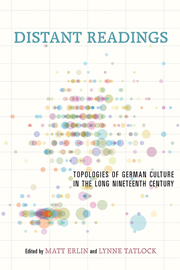Book contents
- Frontmatter
- Contents
- Acknowledgments
- Introduction: “Distant Reading” and the Historiography of Nineteenth-Century German Literature
- I Quantification
- II Circulation
- III Contextualization
- 10 The Vocations of the Novel: Distant-Reading Occupational Change in Nineteenth-Century German Literature
- 11 Big Data, Pattern Recognition, and Literary Studies: N-Gramming the Railway in Nineteenth-Century German Fiction
- 12 “Detoured Reading”: Understanding Literature through the Eyes of Its Contemporaries (A Case Study on Anti-Semitism in Gustav Freytag's Soll und Haben)
- 13 Can Computers Read?
- Selected Bibliography
- Contributors
- Index
10 - The Vocations of the Novel: Distant-Reading Occupational Change in Nineteenth-Century German Literature
from III - Contextualization
Published online by Cambridge University Press: 05 April 2014
- Frontmatter
- Contents
- Acknowledgments
- Introduction: “Distant Reading” and the Historiography of Nineteenth-Century German Literature
- I Quantification
- II Circulation
- III Contextualization
- 10 The Vocations of the Novel: Distant-Reading Occupational Change in Nineteenth-Century German Literature
- 11 Big Data, Pattern Recognition, and Literary Studies: N-Gramming the Railway in Nineteenth-Century German Fiction
- 12 “Detoured Reading”: Understanding Literature through the Eyes of Its Contemporaries (A Case Study on Anti-Semitism in Gustav Freytag's Soll und Haben)
- 13 Can Computers Read?
- Selected Bibliography
- Contributors
- Index
Summary
Within the field of German studies as it has come to being in the United States, narrative prose fiction of the period from 1848 to 1914 has always presented a special disciplinary challenge. Unlike Gustave Flaubert and Émile Zola, Leo Tolstoy and Fyodor Dostoevsky, writers like Gottfried Keller and Berthold Auerbach, Conrad Ferdinand Meyer and Wilhelm Raabe, Adalbert Stifter, and even Theodor Fontane have never become household names in America, and their works are now rarely taught outside of survey courses. Nevertheless, academic critics long ago recognized that narrative prose plays an important role in shaping the collective consciousness of a nation, and over the last thirty years they have developed increasingly sophisticated models to describe the process by which this happens. The early stages of this new period of theoretical sophistication, furthermore, coincided exactly with the “historians' quarrel” of the 1980s, a frequently acrimonious debate about whether the social and political circumstances in Germany during the late nineteenth century had resulted in a so-called Sonderweg, or “separate path into modernity,” that ultimately led to two world wars and the Holocaust. It only made sense, then, to cast particular scrutiny on the narrative fiction produced during the years separating the failed liberal revolution of 1848 from the catastrophic autumn of 1914, when German students marched into Flanders full of conviction that they were fighting to protect a culturally superior national community from the aggression of Western materialism.
- Type
- Chapter
- Information
- Distant ReadingsTopologies of German Culture in the Long Nineteenth Century, pp. 259 - 284Publisher: Boydell & BrewerPrint publication year: 2014

